Improved Military Rifle
Improved Military Rifle (IMR) describes a series of tubular nitrocellulose smokeless powders evolved from World War I through World War II for loading military and commercial ammunition and sold to private citizens for reloading rifle ammunition for hunting and target shooting. These powders were DuPont modifications of John Bernadou's 1897 Naval Torpedo Station patent for nitrocellulose powder colloided with ether and alcohol.[1] IMR powders are coated with dinitrotoluene (DNT) to slow initial burning and graphite to minimize static electricity during blending and loading. They contain 0.6% diphenylamine as a stabilizer and 1% potassium sulfate to reduce muzzle flash.[2]
IMR® is a registered trademark of the IMR Powder Company assigned to the Hodgdon Powder Company, which markets powders under that name.[3]
IMR # 3031
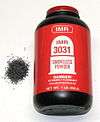
IMR # 16 appeared in 1916 with grains 0.03-inch diameter and 0.085 inches long. Through World War I this powder, and the similar IMR # 17, were used to load military rifle cartridges for France, Russia, and the United Kingdom. In 1923 IMR # 17½ added 2% tin to IMR # 16 to reduce metal fouling from cupronickel-jacketed bullets.[4] Grains of 0.03-inch diameter were 0.084 inches long with 8% DNT coating.[2] IMR # 3031 replaced IMR # 17½ in 1934. IMR # 3031 is intended for mid-range loads and medium sporting and military cartridges like the .257 Roberts, .30-30 and .348 Winchester.[5] Grains of 0.029-inch diameter are 0.083 inches long with 7% DNT coating.[2]
IMR # 4064

The first IMR powder, IMR # 15, was designed in 1914 as a replacement for cordite for the .276 Enfield cartridge.[4] Grains of 0.032-inch diameter were 0.084 inches long with 9% DNT coating. In 1919 IMR # 15½ added 2% tin to IMR # 15 to reduce metal fouling from cupronickel-jacketed bullets.[2] IMR # 4064 replaced both powders in 1935. IMR # 4064 is intended for magnum capacity cartridges like the .250-3000 Savage, .35 Whelen and .375 H&H Magnum.[5] IMR, however, calls 4064 the most versatile powder in its catalog and it works well for a wide range of high-powered rifle cartridges. Grains of 0.031-inch diameter are 0.083 inches long with 6.5% DNT coating.[2]
IMR # 4198
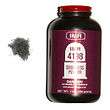
Military Rifle (MR) powder MR # 21 appeared in 1913 for loading traditional sporting cartridges including the self-loading .25, .30 and .32 Remington and the .22 Savage Hi-Power, .25-35 and .30-30 for lever-action rifles. Grains of 0.03-inch diameter were 0.04 inches long. Over the next decade MR # 21 was replaced by IMR # 18 with 0.03-inch diameter grains 0.05 inches long. IMR # 4198 appeared in 1935 as a replacement for IMR # 25½. Comparatively little information has been released concerning IMR # 25½, since DuPont never sold it to handloaders.[4] IMR # 4198 is intended for short range loads and medium capacity cartridges like the .300 Savage, .32 Remington, and .32 Winchester Special.[5] Grains of 0.026-inch diameter are 0.083 inches long with 4.5% DNT coating.[2]
IMR # 4227
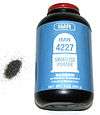
IMR # 1204 powder appeared in 1925 for short lever action cartridges like the .25-20, .32-20, .38-40, and .44-40.[4] Grains of 0.025-inch diameter were 0.021 inches long with 8% DNT coating.[2] IMR # 4227 replaced IMR # 1204 in 1935 for small capacity cartridges like the .22 Hornet, .25-20 and .32-20.[5] Grains of 0.024-inch diameter are 0.023 inches long with 6.5% DNT coating.[2]
IMR # 4320

IMR # 1147 appeared in 1923 for military cartridges like the .30-06 Springfield and the 7.92×57mm Mauser.[4] Grains of 0.034-inch diameter were 0.042 inches long with 8% DNT coating.[2] IMR # 4320 replaced IMR # 1147 in 1935.[4] Grains of 0.034-inch diameter are 0.042 inches long with 6.5% DNT coating.[2] IMR # 4320 is intended for large capacity sporting and military cartridges like the .220 Swift, .270 Winchester and .30-06[5]
IMR # 4350
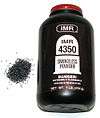
In 1910 MR # 10 was designed for the .280 Ross. Large grains 0.033-inch diameter and 0.12 inches long were intended to slow the burning rate. MR # 10 was replaced by IMR # 13 in 1917 for high-capacity bottleneck cases. Grains of 0.035-inch diameter were 0.08 inches long.[4] IMR # 4350 replaced IMR # 13 in 1940. Grains of 0.038-inch diameter are 0.083 inches long with 5.5% DNT coating.[2]
IMR # 4475
IMR # 4475 was developed in 1936, but not released to handloaders. It was used to load military 7.62×51mm NATO and 5.56×45mm NATO cartridges during the Cold War.[6]
IMR # 4831

IMR # 4831 was used to load Oerlikon 20 mm cannon cartridges through World War II. Salvaged powder became available to civilians when the Oerlikon cannon was declared obsolete following the war.[7] Grains of 0.038-inch diameter are 0.083 inches long with 7% DNT coating. IMR # 4831 contains 1.1% diphenylamine (0.5% more than other IMR powders.)[2]
IMR # 4895
Originally known as 1909 Military or Pyro DG (for Diphenylamine Graphited), 500 tons per day of MR # 20 was manufactured for military loading of the original 150-grain M1906 bullet in the .30-06 through World War I.[4] Grains of 0.03-inch diameter were 0.084 inches long with 9% DNT coating.[2] IMR # 1185 was used when military .30-06 loadings shifted to the 173-grain M1 bullet from 1926 to 1938.[4] Grains of 0.032-inch diameter were 0.084 inches long with 7% DNT coating. IMR #4895 was used for loading the 152-grain M2 bullets in the .30-06 through World War II. Grains of 0.032-inch diameter are 0.056 inches long with 5.5% DNT coating.[2]
Trail Boss
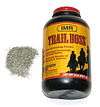
IMR Trail Boss is a bulky powder created in 2005 for use in older cartridges.[8] Old cartridges designed for black powder have a lot of empty space when using modern smokeless powder thus raising the danger of detonation of the powder. IMR created Trail Boss to be bulky enough that handloaders are not able to accidentally double-charge a cartridge. The unique donut-shaped grains are part of what make the powder so bulky.[9] Trailboss is essentially a modern version of the powder developed by Dupont Canada for the CIL/Dominion "Sealing cartridge", a low velocity 30-30 using a lead bullet.
See also
References
- ↑ Davis, Tenney L. The Chemistry of Powder & Explosives (1943) pages 296-297
- 1 2 3 4 5 6 7 8 9 10 11 12 13 14 Davis, William C., Jr. Handloading (1981) National Rifle Association pp.31–32
- ↑ "Trademark Electronic Search System (TESS)". 24 September 2002. Retrieved 13 February 2015.
- 1 2 3 4 5 6 7 8 9 Sharpe, Philip B. Complete Guide To Handloading (1953) Funk & Wagnalls pp.163–172
- 1 2 3 4 5 DuPont Better Loads for Better Shooting (1936) E.I. duPont de Nemours & Company pp.5&6
- ↑ Watters, Daniel E. "The Great Propellant Controversy". The Gun Zone. Retrieved 29 June 2013.
- ↑ Knox, Neal Propellant Profiles (1982) Wolfe Publishing Company pp.45–46 ISBN 0-935632-10-7
- ↑ "IMR Powder Profiles: Trail Boss". IMR Powder. Retrieved 29 September 2010.
- ↑ Venturino, Mike (October 2005). "IMR trail boss powder: finally, a powder to fill those capacious cases". Guns Magazine. Retrieved 29 September 2010.